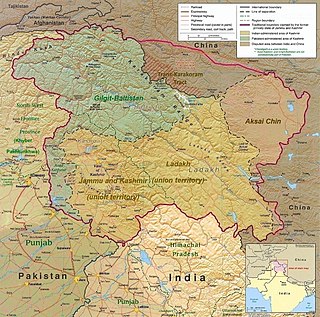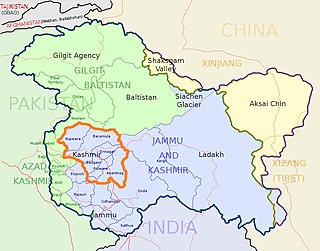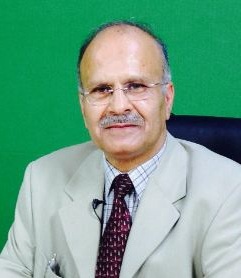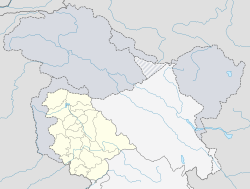
Jammu and Kashmir was a region formerly administered by India as a state from 1954 to 2019, constituting the southern and southeastern portion of the larger Kashmir region, which has been the subject of a dispute between India, Pakistan and China since the mid-20th century. The underlying region of this state were parts of the former princely state of Jammu and Kashmir, whose western districts, now known as Azad Kashmir, and northern territories, now known as Gilgit-Baltistan, are administered by Pakistan. The Aksai Chin region in the east, bordering Tibet, has been under Chinese control since 1962.

The Gilgit Agency was a system of administration established by the British Indian Empire over the subsidiary states of the princely state of Jammu and Kashmir at its northern periphery, mainly with the objective of strengthening these territories against Russian encroachment.

The insurgency in Jammu and Kashmir is an uprising or revolt against the Indian administration of Jammu and Kashmir, a region constituting the southern portion of the larger Kashmir region, which has been the subject of a dispute between India and Pakistan since 1947.
Operation Tupac is the alleged "codename" of an allegedly ongoing "military intelligence" contingency program run by the Pakistani Inter-Services Intelligence (ISI) agency, active since the 1980s. The program has a three-part action plan to provide covert support to separatists in Jammu and Kashmir. It was authorized and initiated by the order of the President of Pakistan Muhammad Zia-ul-Haq in 1988.

The Kashmir conflict is a territorial conflict primarily between India and Pakistan over the Kashmir region. The conflict started after the partition of India in 1947 as a dispute over the former princely state of Jammu and Kashmir and escalated into three wars between India and Pakistan and several other armed skirmishes. China has also been involved in the conflict in a third-party role. Both India and Pakistan claimed the entirety of the former princely state of Jammu and Kashmir, although Pakistan has recognized Chinese sovereignty over the Trans-Karakoram Tract and Aksai Chin since 1963. India controls approximately 55% of the land area of the region and 70% of its population, Pakistan controls approximately 30% of the land, while China controls the remaining 15%. India administers Jammu, the Kashmir Valley, most of Ladakh, and the Siachen Glacier. Pakistan administers Azad Kashmir and Gilgit-Baltistan. China administers the Aksai Chin region, the mostly uninhabited Trans-Karakoram Tract, and part of the Demchok sector.

Poonch or Punch is a district in Jammu and Kashmir, India. With headquarters the town of Poonch, it is bounded by the Line of Control on three sides. The 1947-48 war between India and Pakistan divided the earlier district into two parts. One went to Pakistan and the other became part of the then Indian state of Jammu & Kashmir.

Parole is a town and a notified area committee in Kathua district in the Indian union territory of Jammu and Kashmir.
Girish Chandra 'Gary' Saxena was a governor of Jammu and Kashmir state in India. Born in Agra in 1928 he joined IPS and held many positions in police and retired as Director of the Research and Analysis Wing, India's external intelligence agency. He took over as the head of the State on 2 May 1998 for the second time. Earlier, he held the office of the Governor J&K from 26 May 1990 to 13 March 1993.
Narayanpur or Narayanapur may refer to:

The National Investigation Agency (NIA) is a state agency established by the Indian Government to combat terror in India. It acts as the Central Counter Terrorism Law Enforcement Agency. The agency is empowered to deal with terror related crimes across states without special permission from the states. The Agency came into existence with the enactment of the National Investigation Agency Act 2008 by the Parliament of India on 31 December 2008, which was passed after the deadly 26/11 terror attack in Mumbai. Such an attack clearly surfaced the failure of intelligence and ability to track such activities by existing agencies in India, hence the government of India realized the need of a specific body to deal with terror related activities in India, thereby establishing the NIA. Headquartered in New Delhi, the NIA has branches in Hyderabad, Guwahati, Kochi, Lucknow, Mumbai, Kolkata, Raipur and Jammu. It maintains NIA Most Wanted list.

The 2010 Kashmir unrest was a series of violent protests and riots in the Kashmir Valley which started in June 2010 after the Indian Army claimed to have killed three "Pakistani infiltrators" in which a soldier of the Territorial Army, a counter-insurgent and a former special police officer had found three young men from their Nadihal village in Baramulla district and killed them in a staged encounter at Sona Pindi. The protests occurred in a movement launched by Hurriyat Conference led by Syed Ali Shah Geelani and Mirwaiz Umar Farooq in the Indian state of Jammu and Kashmir in June 2010, who called for the complete demilitarisation of Jammu and Kashmir. The All Parties Hurriyat Conference made this call to a strike, citing human rights abuses by security forces. Rioters shouting pro-independence slogans, defied curfew, attacked riot police with stones and burnt vehicles and buildings. The protests started out as anti India protests but later were also targeted against the United States following the 2010 Qur'an-burning controversy. The riot police consisting of Jammu and Kashmir Police and Indian Para-military forces fired teargas shells rubber bullets and also live ammunition on the protesters, resulting in 112 deaths, including many teenagers and an 11-year-old boy. The protests subsided after the Indian government announced a package of measures aimed at defusing the tensions in September 2010.

The Jammu and Kashmir Police or JKP, was established in 1873 and is the law enforcement agency, having primary responsibilities in law enforcement and investigation within Jammu and Kashmir in India. The department serves an area of 85,806 square miles and a population of 12,548,926 people at the 2011 census.
The Inter-Services Intelligence (ISI), intelligence agency of Pakistan has been involved in planning, preparing and carrying-out terrorist attacks against the people of Indian and running so-called "military intelligence" programs in India, with one of the subsections of its Joint Intelligence Bureau (JIB) department devoted to carrying out these acts of terrorism in India. The Joint Signal Intelligence Bureau (JSIB) department has also been involved in providing communications support to Pakistani terrorists operating in regions of the State of Jammu and Kashmir of India. The Joint Intelligence North section of the Joint Counter-Intelligence Bureau (JCIB) wing deals particularly with India. In the 1950s the ISI's Covert Action Division supplied arms to insurgents in Northeast India.
Lohara is a village in Zafarwal Tehsil, Narowal District of Punjab, Pakistan. It is in the Basantar River Valley, west of the river on the Darmaan-Shakargarh Road from Shakargarh to Zafarwal. Lohara is just south of Indian-administered Kashmir, one kilometre east of the village of Hamral, and 3.5 km west of the village of Nahr. The people speak the Kangri language which is either a dialect of Punjabi or a dialect of Western Pahari, depending upon one's political persuasion.

Jammu is the winter capital and the largest city in Jammu district of the Indian union territory of Jammu and Kashmir. Lying on the banks of the river Tawi, the city of Jammu, with an area of 26.64 km2 (10.29 sq mi), is surrounded by the Himalayas in the north and the northern-plains in the south. Jammu is the second most populous city of the union territory.
Dineshwar Sharma, is a 1976-batch Kerala cadre, retired Indian Police Service (IPS) officer. He was the chief of the Indian Intelligence Bureau, that is the Director of Intelligence Bureau which is the highest-ranked post in the Indian Police Service (IPS). He also served as an interlocutor to the government of India for the state of Jammu and Kashmir. Currently he's serving as the 34th Administrator of Lakshadweep.

Shabir Choudhry is a British national and a Kashmiri leader, rights and peace activist, politician, academician and writer. He helped form the Kashmir Youth Movement in 1973, the Jammu and Kashmir Liberation Front in 1976 and later on the Kashmir National Party in 2008. He resigned from each of these after being discouraged or opposed to the direction they were headed. He went to United Kingdom in 1966 where he continues his struggle against forces of occupation, terrorism, extremism and religious intolerance in Azad Kashmir and Kashmir through regular statements, articles, press releases, conference and videos. He is a British national as well as a Pakistani/Kashmiri national.

Jammu and Kashmir is a region administered by India as a union territory, and constituting the southern portion of the larger Kashmir region, which has been the subject of a dispute between India and Pakistan since 1947, and between India and China since 1962. The region of Jammu and Kashmir is separated by the Line of Control from the Pakistani-administered territories of Azad Kashmir and Gilgit-Baltistan in the west and north respectively. It lies to the north of the Indian states of Himachal Pradesh and Punjab and to the west of Ladakh, which is also subject to the dispute as a part of Kashmir, and administered by India as a union territory.
The Jammu and Kashmir Reorganisation Act, 2019 is an act of the Parliament of India containing provisions to reconstitute the Indian-administered state of Jammu and Kashmir, a part of the larger region of Kashmir which has been the subject of dispute among India, Pakistan, and China since 1947, into two Indian-administered union territories called Jammu and Kashmir, and Ladakh, on 31 October 2019. A bill for the act was introduced by the Minister of Home Affairs, Amit Shah, in the Rajya Sabha on 5 August 2019 and was passed on the same day. It was then passed by the Lok Sabha on 6 August 2019 and it received the President's assent on 9 August 2019.













